History
The personalities, ideological setting, and resource base are proof that the history of RSU is closely tied in with the history of higher education in medicine in Latvia in general.
The history of Rīga Stradiņš University (RSU) dates back to 1 September 1950. On that day in Riga, at 12 Z. A. Meierovica bulvāris (at that time named Padomju bulvāris), in the building that was donated by the pre-war patron Kristaps Morbergs for educational purposes, the forerunner of the RSU – Rīga Medical Institute (RMI) opened its doors for the first time.
The RMI was established on the basis of the Faculty of Medicine at the University of Latvia, which is the direct successor of the pre-war Faculty of Medicine at the University of Latvia.
The Stradiņš’ name is not a coincidence. Members of the Stradiņš family have had a major influence on the public and academic life of Latvia over the past century. The timely and highly professional activity of Pauls Stradiņš – one of the two professors of medicine remaining in Latvia after the World War II, Dean of the Faculty of Medicine of the University of Latvia – ensured continuity of the values, standards and quality of medical education and built a bridge between the pre-war and post-war education and science of Latvia, as well as laid strong foundations for the establishment and development of the Rīga Medical Institute (RMI).
The first Director of the RMI was professor Ernests Burtnieks. Initially there were three faculties – the Faculties of Medicine, Stomatology and Pharmacy; academic work was organised in 45 departments. Gradually almost all the hospitals in Riga and its surrounds, as well as some of the ambulatory medical institutions were involved in study and research work.
On 30 December 1969 the Faculty of Stomatology moved to the new Stomatology Health Centre building in Pārdaugava, at 20 Dzirciema iela. On 30 September 1987 the first stage of the newly constructed RMI building complex was opened next door; at 16 Dzirciema iela. 16000 m2 that is now the premises of the RSU were gradually furnished to house more than 1000 offices, lecture-rooms, laboratories and administrative premises.
In 1990 the Rīga Medical Institution was renamed the Medical Academy of Latvia (Academia Medicinae Latviensis or AML), but in 1998 the Constitutional Assembly approved the new name – Rīga Stradiņš University. Within nearly ten years the Medical Academy had turned into a university college, educating high quality specialists of medicine and pharmacy, rehabilitation, nursing, public health and social sciences. In 2002 the Saeima of Latvia adopted the law on the RSU Constitution.
In 2009 at 16 Dzirciema iela the main venue for ceremonies – the Great Hall – was opened, thus putting a symbolic end to the development of the RSU as an independent and fully fledged educational and scientific institution.
RSU is the only university in Latvia that has traditionally been closely integrated within the health care system, providing preconditions for the successful operation of Latvian medical institutions. Currently nine faculties at the RSU offer Bachelor, Master and Doctoral degree, professional and continuing education programmes. Anyone, starting from a high school graduate to a PhD, can gain a new qualification, improve their knowledge, as well as give their contribution to the creation of new knowledge and technologies. The high quality education provided by the RSU gains more and more popularity among foreign students.
On 1 July 2024, in accordance with the decision of the Ministry of Education and Science, the Latvian Academy of Sport Education (LASE) was integrated into RSU, while retaining its identity, as well as its academic and scientific autonomy. Its official name is the Rīga Stradiņš University Latvian Academy of Sport Education.
The current rector of the university is Prof. Aigars Pētersons.
Photo album and memories of Paulis Cīrulis
In May 2017 we celebrated the 100th anniversary of Paulis Cīrulis – the long-standing photographer and head of the Photo and Cinema Laboratory of the Riga Medicine Institute that was the forerunner of RSU. The RSU Museum invited former students to share their memories about their time at the university. The memories are related to the photographs taken by P. Cīrulis.
- Story of the Dean of the RSU Faculty of Dentistry, Professor Ilga Urtāne
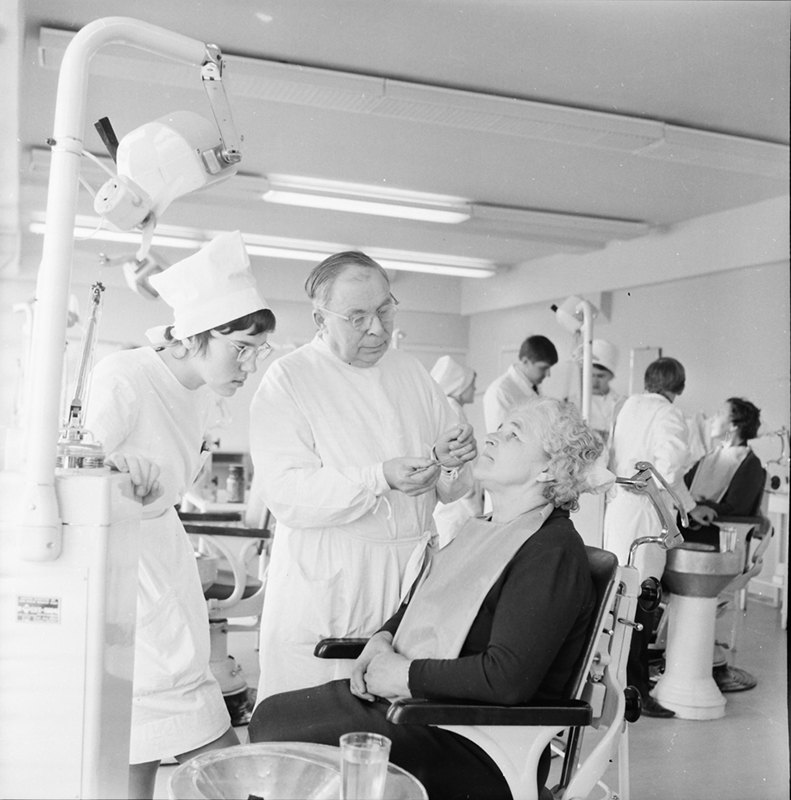 It is the 1970s and Professor Dominiks Kalvelis is holding the practical class of Orthopaedic Stomatology. The study clinics were equipped with facilities and chairs manufactured in the Volgograd factory. The treatment procedure was carried out with the patient sitting in the chair and the doctor standing. The possibilities for manipulations and the use of materials were limited. Polishing and other manipulations were performed without anaesthesia. The patience of people was admirable; however, since then the fear of dentists has remained for several generations. The material for dental impressions was gypsum. The only aesthetic material for dentures was plastic; teeth were restored with the methods that were available. Although the material and technical supply was insufficient, the atmosphere in the department was very pleasant; the lecturers, students and patients shared mutual respect.
It is the 1970s and Professor Dominiks Kalvelis is holding the practical class of Orthopaedic Stomatology. The study clinics were equipped with facilities and chairs manufactured in the Volgograd factory. The treatment procedure was carried out with the patient sitting in the chair and the doctor standing. The possibilities for manipulations and the use of materials were limited. Polishing and other manipulations were performed without anaesthesia. The patience of people was admirable; however, since then the fear of dentists has remained for several generations. The material for dental impressions was gypsum. The only aesthetic material for dentures was plastic; teeth were restored with the methods that were available. Although the material and technical supply was insufficient, the atmosphere in the department was very pleasant; the lecturers, students and patients shared mutual respect.- Story of the Head of the Department of Paediatrics at the RSU Faculty of Medicine, Professor Dace Gardovska
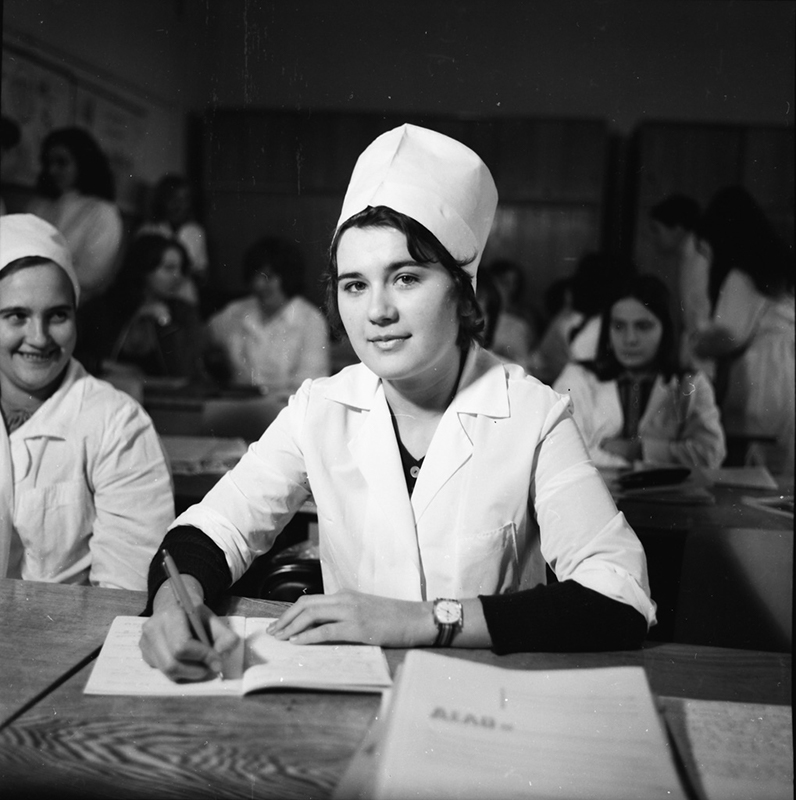 This photo was taken in 1970s, when I was studying at the Faculty of Paediatrics. Mr. Paulis Cīrulis came shortly before the start of the surgery class to take a photo of me, as requested by the editorial staff of the institute newspaper, as I was a socially active excellent student and head of the class. This photo is good evidence of the study culture – at that time participation in lectures was as mandatory as participation in practical classes. We had to wear a clean, well-ironed lab coat and hat when attending lectures in clinical subjects; the same rules also applied to the teaching staff.
This photo was taken in 1970s, when I was studying at the Faculty of Paediatrics. Mr. Paulis Cīrulis came shortly before the start of the surgery class to take a photo of me, as requested by the editorial staff of the institute newspaper, as I was a socially active excellent student and head of the class. This photo is good evidence of the study culture – at that time participation in lectures was as mandatory as participation in practical classes. We had to wear a clean, well-ironed lab coat and hat when attending lectures in clinical subjects; the same rules also applied to the teaching staff.The students took notes diligently. Usually lecturers tried to incorporate their own experience in lectures and use some of the newest materials that were not available to the public. Patients were often invited to participate in lectures, who publicly outlined their complaints, students were demonstrated the symptoms, analysed diagnostics and treatment methods. Lectures were supplemented by large-format charts, a blackboard and the personality of the lecturer that either was or was not able to engage the audience. New technologies came in gradually – e.g. slides. I remember the time when later, as a fledgling lecturer I tried to write the lecture material on old, "washed" x-ray photographs. During the lecture by placing them on a graphics projector the images slightly helped to illustrate the topic.
It is possible that this is the photograph that was published in the newspaper Padomju Jaunatne and was entered in a photo contest; it ended up in a prison library, and several letters addressed to me were sent to the Rīga Medical Institute. The unique stamp on the letters attracted attention; therefore they first landed on the desks of the Dean and the Vice-Rector for Education. To receive the letters I was asked to explain the situation. We opened the letters together and discovered that the authors are prisoners, who were expressing their friendship. From that time I have learned that, when being in public anyone can find themselves in an ambiguous situation, so one can never be too cautious.
- Story of a long-standing employee of the State Blood Donor Centre, doctor Irēna Danilāne
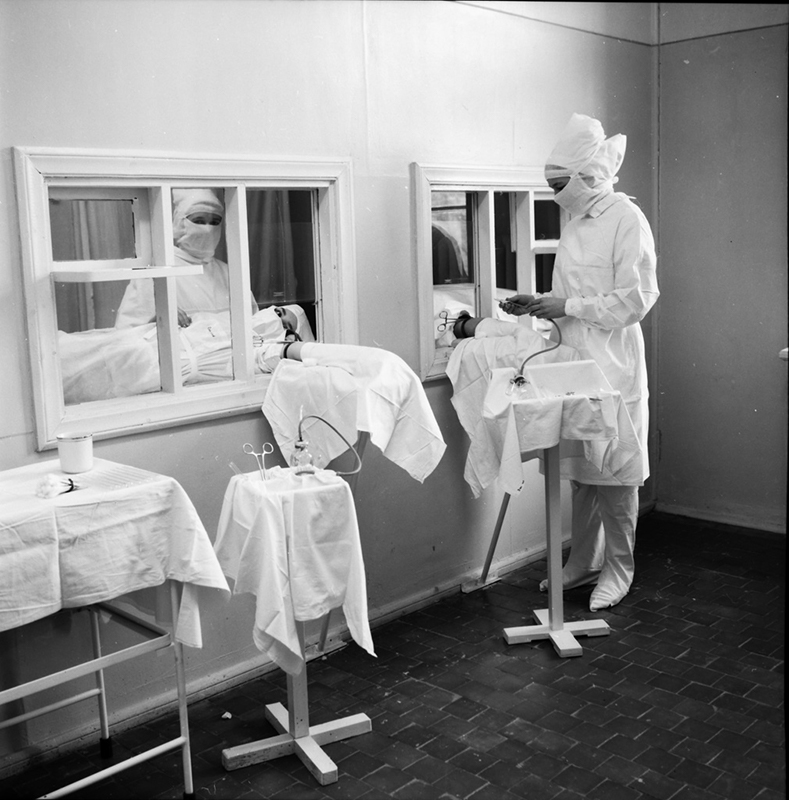 The photo shows a sterile box, where a nurse is taking blood from a patient's arm that is accessed through a window. All preservatives at that time were prepared on site; therefore we had to observe strict sterility requirements.
The photo shows a sterile box, where a nurse is taking blood from a patient's arm that is accessed through a window. All preservatives at that time were prepared on site; therefore we had to observe strict sterility requirements.Both the doctors and the donors had to wear sterile coats (gowns), fabric knee-high socks (overshoes) and face masks. You could not recognise anyone. Donors did not wear outdoor clothes under the overalls and while sitting in line before donating blood the only giveaway whether it was a female or male donor, was their leg hair.
Around the 1980s, when sterile preservatives were manufactured industrially, the donors wrote complaints to the USSR Ministry of Health, saying that sterility requirements for blood donors are being violated in the Latvian SSR – they no longer were required to wear sterile gowns and face masks. It made the staff smile.
- Story of the Dean of the Faculty of Pharmacy (1968–2008), associate professor Vija Eniņa
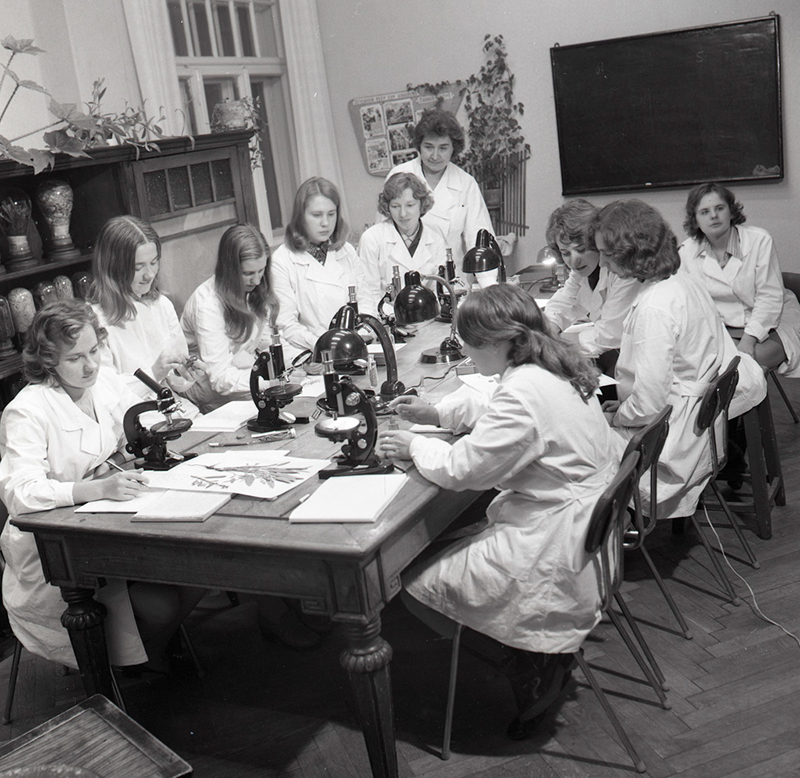 One of the specific subjects offered at the Faculty of Pharmacy was and still is pharmacognosy – the study of medicinal plants, their structure, their chemical composition and use in healthcare. The picture shows 3rd year students in a practical class in pharmacognosy – they are studying the structure of medicinal plant drugs under the microscope. The class is held at 5 Veidenbauma (current Baznīcas) iela, where the departments of the Faculty of Pharmacy were located at that time. The class is held by the head lecturer Helēna Rubine. Very smart, strict, demanding and categorical – many students were afraid of her, as it was not easy to prepare for her seminars or exams. I have been both a student of H. Rubine and after my doctoral studies also her colleague in the same department. I was in charge of another subject – botany for 1st year students that was one of the basic subjects for further pharmacognosy studies.
One of the specific subjects offered at the Faculty of Pharmacy was and still is pharmacognosy – the study of medicinal plants, their structure, their chemical composition and use in healthcare. The picture shows 3rd year students in a practical class in pharmacognosy – they are studying the structure of medicinal plant drugs under the microscope. The class is held at 5 Veidenbauma (current Baznīcas) iela, where the departments of the Faculty of Pharmacy were located at that time. The class is held by the head lecturer Helēna Rubine. Very smart, strict, demanding and categorical – many students were afraid of her, as it was not easy to prepare for her seminars or exams. I have been both a student of H. Rubine and after my doctoral studies also her colleague in the same department. I was in charge of another subject – botany for 1st year students that was one of the basic subjects for further pharmacognosy studies.Comparing the study environment back then and now, the difference is obvious – in a room that was adapted for studies (a former residential apartment), 9-10 students worked close by each other at one table. Each had their own microscope; however they were not very handy – the fitting pipe of most of them was vertical causing additional stress on the neck muscles. The light that is very important for microscopy was rather inadequate. It was rather difficult for the lecturer to get to the students’ microscopes to show the necessary element of anatomical structure. However, despite the difficulties of the study process, it was interesting. Many of the students in the picture are now competent and experienced pharmaceutists and pharmacy managers.
- Story of Gynaecologist, Obstetrician Dace Matule
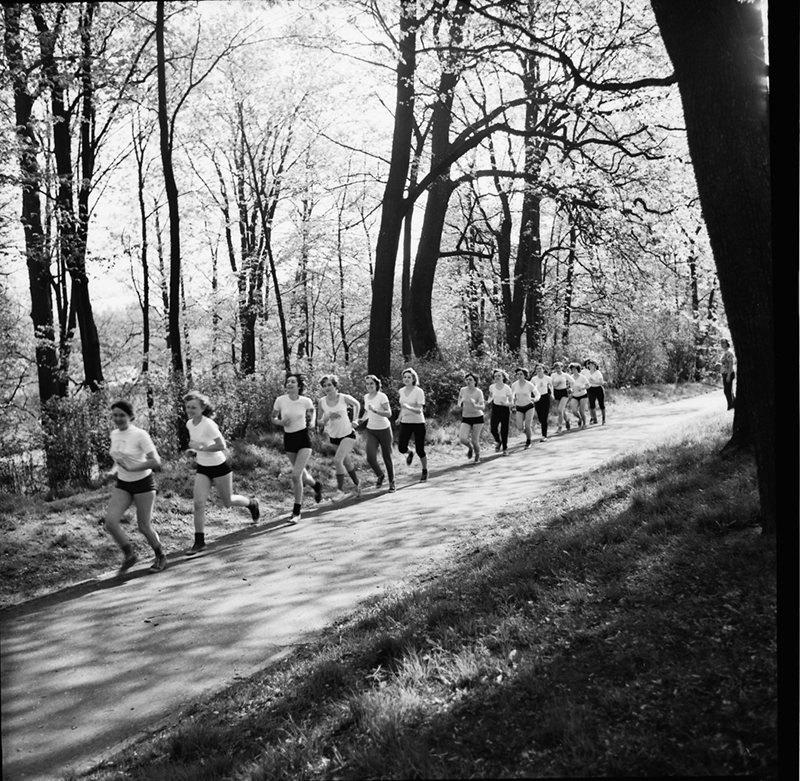 This picture does not show me, as I never ran in the classes – neither the classes of B. Banga, nor anyone else. I enjoyed a privileged status and during my studies at the Riga Medicine Institute I was in the national Latvian track and field athletic team and we did not have to attend sports classes.
This picture does not show me, as I never ran in the classes – neither the classes of B. Banga, nor anyone else. I enjoyed a privileged status and during my studies at the Riga Medicine Institute I was in the national Latvian track and field athletic team and we did not have to attend sports classes.But I will tell you one of the most colourful stories that I experienced during the winter semester of the 3rd year. My group mate and friend had to attend classes with B. Banga and after every sports class she came to the next class with red cheeks. They always had to run – no matter the season or weather. In the 3rd year she got pregnant and due to morning sickness she had missed several classes. The winter semester tests approached and she had so many missed classes, and the delivery date was not far… Today we know that physical activities during pregnancy substantially improve oxygen supply to the child. Studies have shown that the children of pregnant women, who exercised three times a week, have comparatively better language skills and a higher IQ already at 5 years of age.
But about my friend – she had to catch up on all the missed classes if she wanted to finish the semester. It seemed she was not even allowed to give birth… Every day she walked around the Māra Pond until she had clocked up the necessary distance. Her baby girl was born in time and she later acquired two university degrees without any problems – maybe because of her mother’s long walks around the Māra Pond.
- Story of Doctor, RMI graduate and former RSU lecturer Irīna Kalniņa
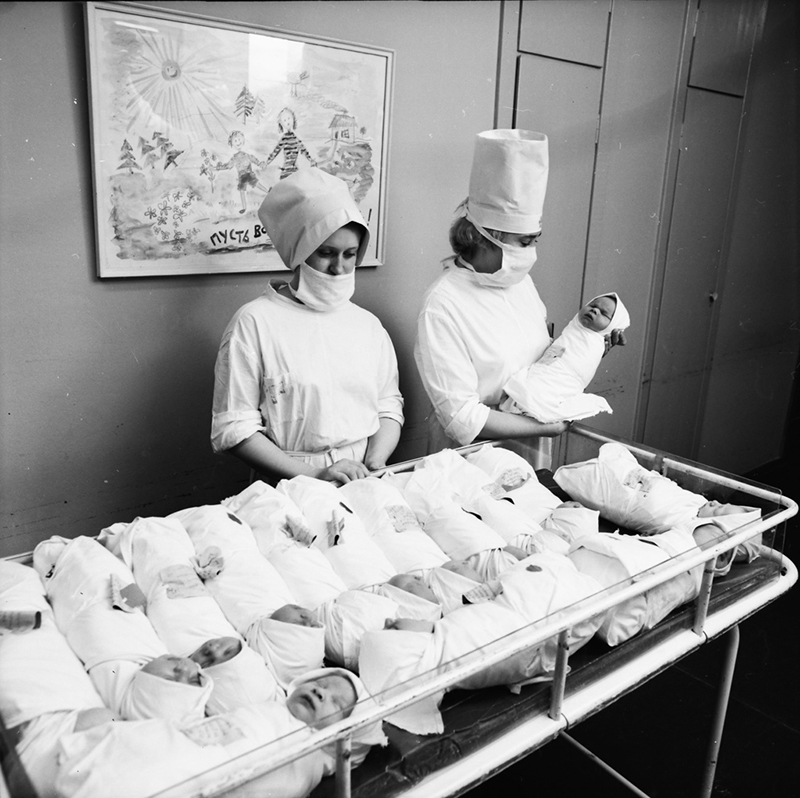 This is how the Birthing Departments looked. The babies most probably have been taken back from nursing – sleeping calmly, nobody is crying, they must be full. I studied paediatrics at the Rīga Medical Institute in the 1980s and the main wish of paediatrics students back then was to participate in childbirth. The placement often was in the birthing departments in hospitals in Riga, not the Maternity Hospital.
This is how the Birthing Departments looked. The babies most probably have been taken back from nursing – sleeping calmly, nobody is crying, they must be full. I studied paediatrics at the Rīga Medical Institute in the 1980s and the main wish of paediatrics students back then was to participate in childbirth. The placement often was in the birthing departments in hospitals in Riga, not the Maternity Hospital.At that time the newborn was not placed in the same room as the mother – they only met when being nursed. Nurses transported children to their mothers on trolleys. Babies had to fit in standard size trolleys. Babies who were too big were carried by the nurses. That's how it was.
- Story of the ex-president of the Republic of Latvia Valdis Zatlers*
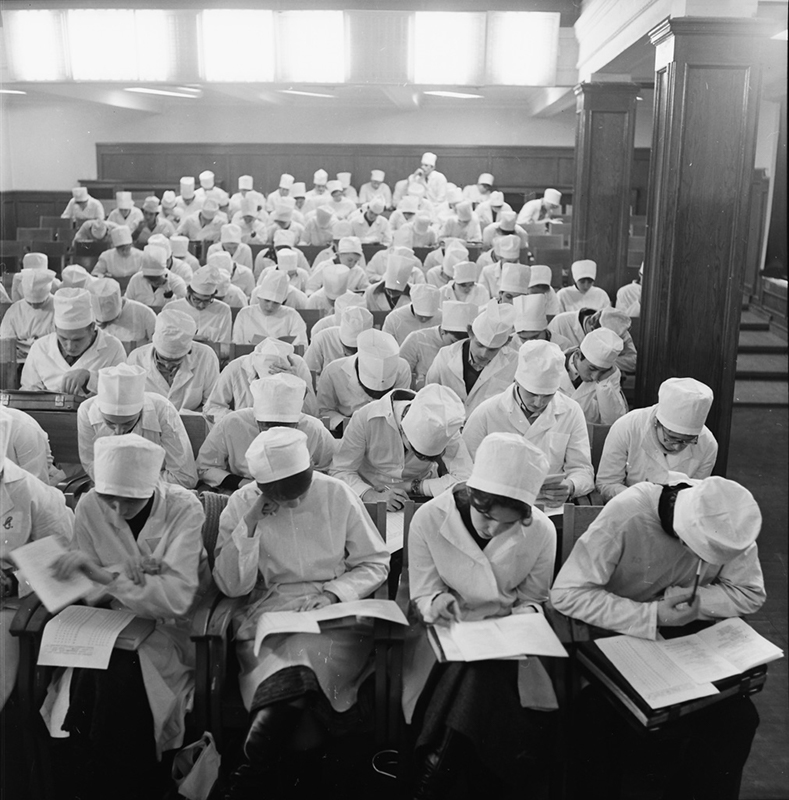 I passed the state examination in therapy with distinction. I still cannot understand how. Who would study in June!? When a day before the exam I attended the consultation (extra lesson), I understood that I do not have time to read and learn everything. I asked my former classmate and at that time fellow student Gunta Arāja (now professor Lazdāne, who works for the World Health Organisation): “Help me! Tell me at least the most important things! I have no time left!” Gunta went through about one third of the work, another third I read until three in the morning, and I only read the headings of the remaining part, but still I passed the exam. Half asleep, I waited for the results. When, after professor Ilmārs Lazovskis had expressed the compliment “One of the students impressed us with his particularly good knowledge…”, I heard my name, I was startled. That was too much even for me!
I passed the state examination in therapy with distinction. I still cannot understand how. Who would study in June!? When a day before the exam I attended the consultation (extra lesson), I understood that I do not have time to read and learn everything. I asked my former classmate and at that time fellow student Gunta Arāja (now professor Lazdāne, who works for the World Health Organisation): “Help me! Tell me at least the most important things! I have no time left!” Gunta went through about one third of the work, another third I read until three in the morning, and I only read the headings of the remaining part, but still I passed the exam. Half asleep, I waited for the results. When, after professor Ilmārs Lazovskis had expressed the compliment “One of the students impressed us with his particularly good knowledge…”, I heard my name, I was startled. That was too much even for me!Ironically – my saviour, absolutely outstanding student Gunta got her only mark of "four" in this exam. How unfair! I was ashamed. If it were possible I would swap our grades. However, I have to admit that my luck was based on my ability to observe people, notice their illnesses and their peculiarities.
* An excerpt from the book “Valdis Zatlers. Who am I”, Riga, Jumava, 2015, 57 pages. With the kind permission of V. Zatlers
- Story of the Chairman of the Council of Higher Education, RSU professor Jānis Vētra
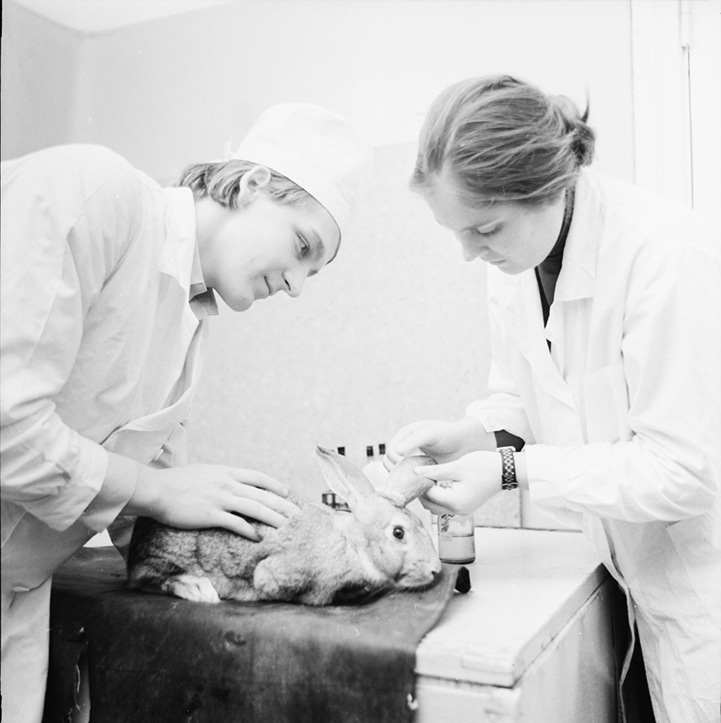 Here you can see the class of Pathologic Physiology held at the Department of Pathologic Physiology of the Rīga Medical Institute, located within the territory of the Pauls Stradiņš Republican Clinical Hospital. The theme of the class most probably was an inflammation that was modelled in a rabbit’s ear. Students usually were more interested in the rabbit than his reddened ear – whether it will sit still or break away, or start jumping around the lecture room… There was much to see in experiments with animals. Rabbits were held in cages in the basement downstairs. Participation in the experiment was an adventure for the animal – a trip from the basement to the company of people. But we all were all witnesses to the fact that the saying as scared as a rabbit is not just someone's imagination. When taken to the lecture room and held tightly in a student’s hands, the rabbits grew stiff. You can see that in this picture. The emotions in the rabbit’s face are paralysed; in comparison – the serious, curious faces of the students. There were cases when the rabbit was so alarmed from being in the spotlight, that its heart stopped and it died.
Here you can see the class of Pathologic Physiology held at the Department of Pathologic Physiology of the Rīga Medical Institute, located within the territory of the Pauls Stradiņš Republican Clinical Hospital. The theme of the class most probably was an inflammation that was modelled in a rabbit’s ear. Students usually were more interested in the rabbit than his reddened ear – whether it will sit still or break away, or start jumping around the lecture room… There was much to see in experiments with animals. Rabbits were held in cages in the basement downstairs. Participation in the experiment was an adventure for the animal – a trip from the basement to the company of people. But we all were all witnesses to the fact that the saying as scared as a rabbit is not just someone's imagination. When taken to the lecture room and held tightly in a student’s hands, the rabbits grew stiff. You can see that in this picture. The emotions in the rabbit’s face are paralysed; in comparison – the serious, curious faces of the students. There were cases when the rabbit was so alarmed from being in the spotlight, that its heart stopped and it died.- Story of the Director of the RSU Museum of the History of Medicine, Professor Juris Salaks
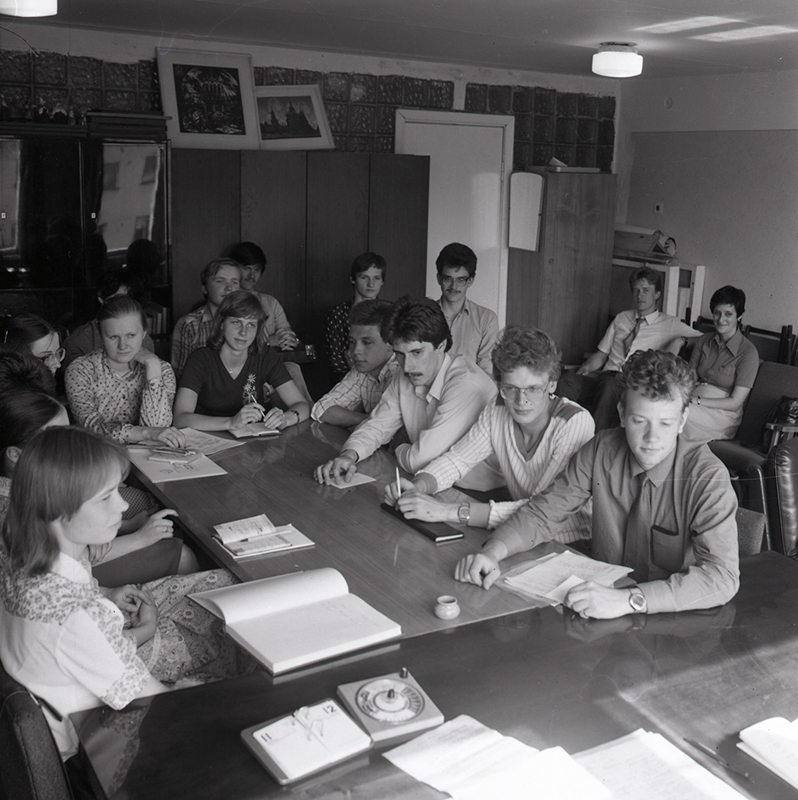 The picture has captured a board meeting of the Riga Medicine Institute Students’ Scientific Society around 1985. The meetings were usually held in the new premises of the RMI dormitories at 17A Mārupes iela. There was a special niche in the hall that initially was intended as a rest area for the residents of the dormitory. Later it was separated by glass walls – blocks that during Soviet times were used in bathrooms.
The picture has captured a board meeting of the Riga Medicine Institute Students’ Scientific Society around 1985. The meetings were usually held in the new premises of the RMI dormitories at 17A Mārupes iela. There was a special niche in the hall that initially was intended as a rest area for the residents of the dormitory. Later it was separated by glass walls – blocks that during Soviet times were used in bathrooms.
The photo shows students, who are now renowned doctors. First on the right is Askolds Akers, who follows family tradition and is an otorhinolaryngologist. I'm second on the right. At the head of the table (wearing a dark blouse) sits Maira Jansone, who now is a lecturer at the Department of Obstetrics and Gynaecology at our university. Egils Harasimjuks (at the back, with glasses) works at the Ministry of Health. First on the left is Zita Grudule. Fourth on the left, with glasses, is now a highly honoured professor Māra Pilmane. There are also girls from the Russian group, whose names I cannot recall.Scientific leader was Professor Juris Leja, who is not visible in this photo. Chairman of the meetings was docis – a nickname derived from the word docents (Assistant Professor). Our docis was Aivars Bērziņš, who unfortunately has passed away. After graduation from the RMI he continued studies in the USA, where he stayed and continued working.
What were we discussing? Most probably organising the regular conference of the Students’ Scientific Society – the agenda, organisation, and maybe how many barrels of beer we will need after the conference – for the closing party.
- Story of the Head of the Endocrinology Centre of the Pauls Stradiņš Clinical University Hospital, Professor Valdis Pīrāgs
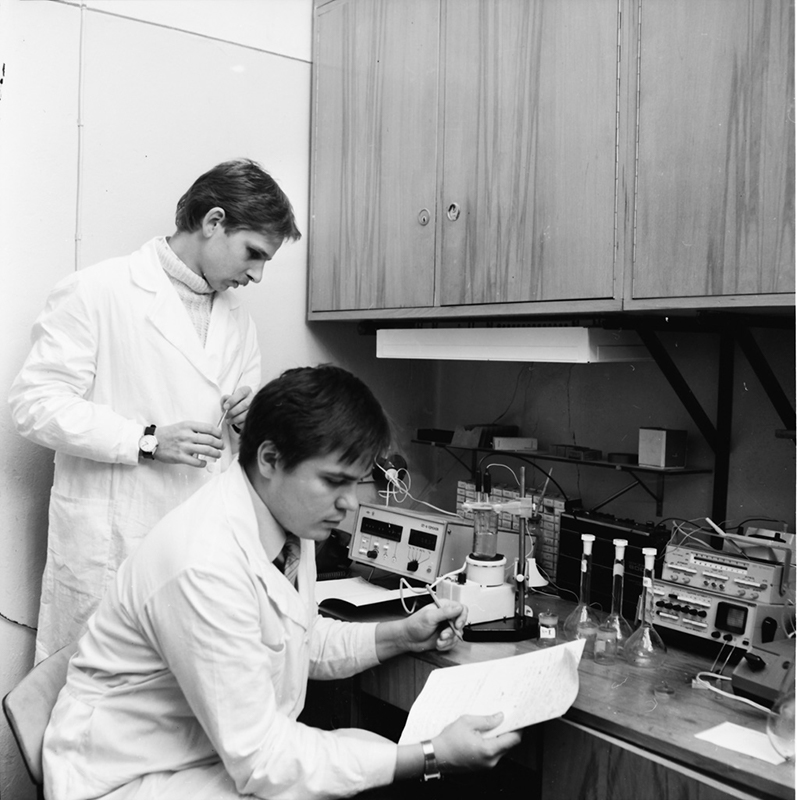 In the autumn of 1985, Head of the Department of Pathologic Physiology of the Rīga Medical Institute, Professor Juris Leja, invited me to join the scientific group, the main research direction of which was study of physiology of the alimentary tract. In the picture I am with another student Aleksandrs Simonāvičs – we are carrying out the measurement of the electrolyte content in gastric juices, trying to link the changes of potassium and sodium ion concentration with various gastric and duodenum illnesses. Back then the RMI Students’ Scientific Society was very powerful and prestigious; conferences were held each year gathering participants not only from medicine institutes in Estonia, Lithuania, Russia, Ukraine, Belarus, the Caucasus and Central Asia republics, but since 1988 also from the German Democratic Republic, Hungary, and since 1989 from universities of the German Federative Republic, Finland, Sweden and other countries. For three years I had the honour of chairing the Students’ Scientific Society following my forerunners Juris Salaka, Aivars Bērziņš and Jānis Vētra. We only informed Rector Vladislavs Korzāns about the arrival of foreign students when they were already in Riga. Although according to the laws of that time citizens of Western countries were only allowed to stay in the “Latvia” hotel that was under special supervision, the Rector let us deal with this issue at our discretion and at our own expense. The guests were hosted by student families and we had a fun party in the student dormitory, which was stopped by the superintendent at dawn. The girls from Finland got away using the escape pipe, but the Germans were caught.
In the autumn of 1985, Head of the Department of Pathologic Physiology of the Rīga Medical Institute, Professor Juris Leja, invited me to join the scientific group, the main research direction of which was study of physiology of the alimentary tract. In the picture I am with another student Aleksandrs Simonāvičs – we are carrying out the measurement of the electrolyte content in gastric juices, trying to link the changes of potassium and sodium ion concentration with various gastric and duodenum illnesses. Back then the RMI Students’ Scientific Society was very powerful and prestigious; conferences were held each year gathering participants not only from medicine institutes in Estonia, Lithuania, Russia, Ukraine, Belarus, the Caucasus and Central Asia republics, but since 1988 also from the German Democratic Republic, Hungary, and since 1989 from universities of the German Federative Republic, Finland, Sweden and other countries. For three years I had the honour of chairing the Students’ Scientific Society following my forerunners Juris Salaka, Aivars Bērziņš and Jānis Vētra. We only informed Rector Vladislavs Korzāns about the arrival of foreign students when they were already in Riga. Although according to the laws of that time citizens of Western countries were only allowed to stay in the “Latvia” hotel that was under special supervision, the Rector let us deal with this issue at our discretion and at our own expense. The guests were hosted by student families and we had a fun party in the student dormitory, which was stopped by the superintendent at dawn. The girls from Finland got away using the escape pipe, but the Germans were caught.- Story of the Associated Professor of the RSU Department of Human Physiology and Biochemistry Leons Blumfelds
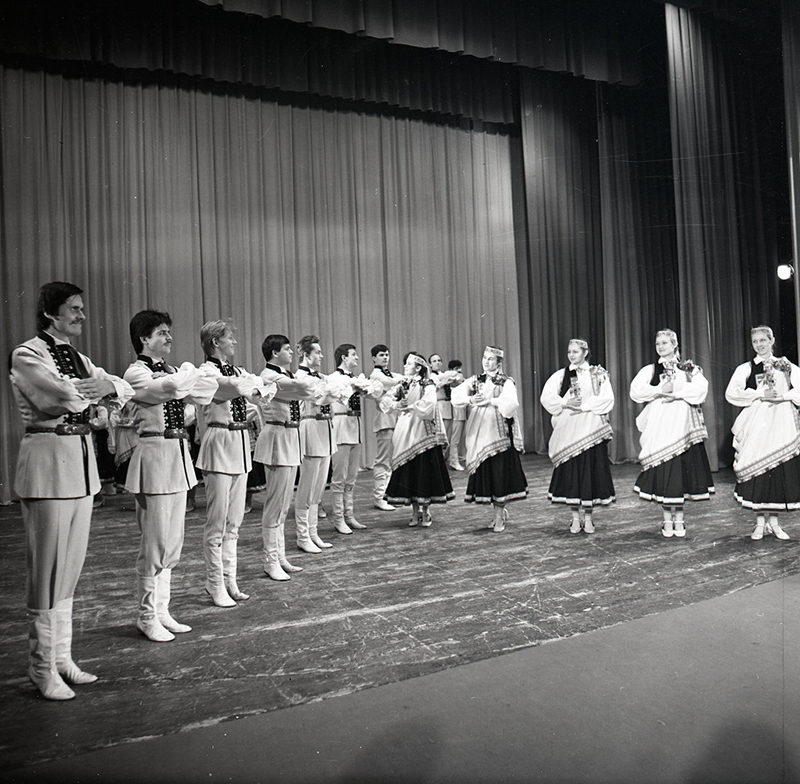 Yes, it seems a while since this photo was taken. It was the time when Ačkups won the Folk Dance group honorary title. Photographer Paulis Cīrulis memorialised a moment from the Gatves deja (popular Latvian folk dance) on the stage of VEF Cultural palace.
Yes, it seems a while since this photo was taken. It was the time when Ačkups won the Folk Dance group honorary title. Photographer Paulis Cīrulis memorialised a moment from the Gatves deja (popular Latvian folk dance) on the stage of VEF Cultural palace.I still think that when I was involved in folk dancing was one of the most interesting and valuable periods of my life. Why? People, who have danced or still dance, will understand me. It is an exciting world of rehearsals and concerts, getting to know the cultures of various nations, improving oneself, goods friends, the joy of being together, and… and… It is hard to put that into words.
What has still remained today? Beautiful memories and values for the soul and character that cannot be taken away.
- Story of the Head of the Operating Block at the Gaiļezers Hospital, doctor Pēteris Tomiņš
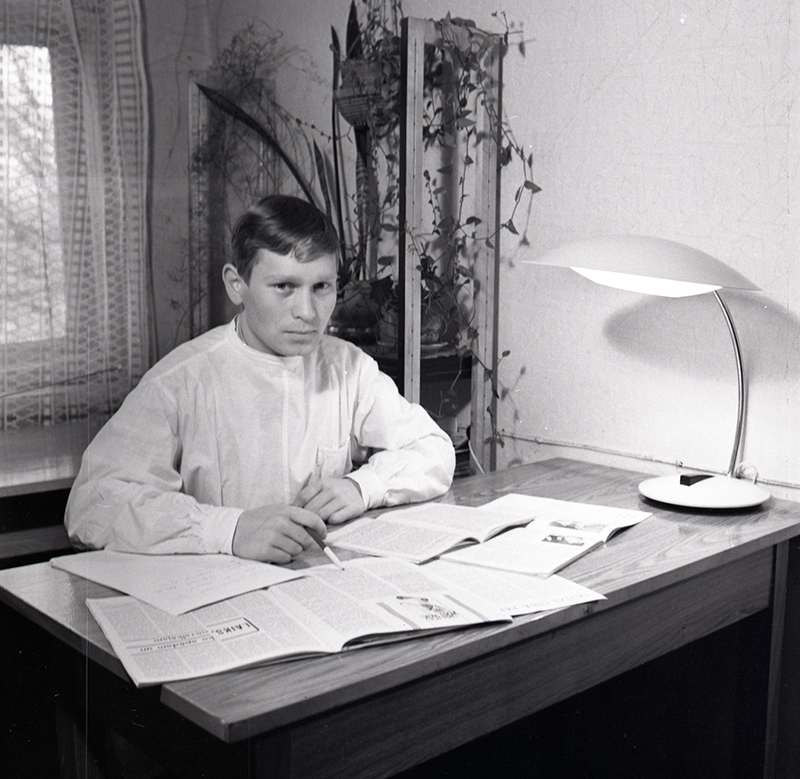 For several years I was the Vice-President of the Rīga Medical Institute (RMI) Interclub. Interclub – without a doubt! – was the most fun and the best appendix of the RMI Komsomol Committee. At least that is the opinion of the members of the club, who still maintain contact. The club, mainly in a declarative way, was involved in the education of the students in the spirit of “friendship of nations”, i.e. what the administration had intended. There were at least two departments at the institute for the shaping of the students’ world view, supervised by a vice-rector. Owing to the endeavours of the parties involved or in spite of them, the friendships existed – a true friendship that had little to do with the national affiliation of the students.
For several years I was the Vice-President of the Rīga Medical Institute (RMI) Interclub. Interclub – without a doubt! – was the most fun and the best appendix of the RMI Komsomol Committee. At least that is the opinion of the members of the club, who still maintain contact. The club, mainly in a declarative way, was involved in the education of the students in the spirit of “friendship of nations”, i.e. what the administration had intended. There were at least two departments at the institute for the shaping of the students’ world view, supervised by a vice-rector. Owing to the endeavours of the parties involved or in spite of them, the friendships existed – a true friendship that had little to do with the national affiliation of the students.The main practical task of Interclub was to organise exchange placement of students – our students went for a month to the German Democratic Republic, the Hungarian People’s Republic, the Polish People's Republic, the Bulgarian People’s Republic, their students came to Latvia and had a small tour in the USSR accompanied by our students as guides. The highlight of the placement period was a reception held by the Rector of the RMI. That was also organised by the Interclub. Hungarians had brought a souvenir – a bottle of Tokaji. Towards morning the bottle was there, but without the wine. Respect to the Rector Vladislavs Korzāns – he took it without unnecessary emotions, and there were no sanctions from his side.
It turned out, students from brotherly Poland, who were not so brotherly towards each other, had spent their last night in Latvia outside Riga – in the restaurant “Sēnīte”; and without their mandatory guide. A couple of hours before their departure to Tallinn they found out that they had left their passports in a bus they caught back to Riga in the morning. As an old Latvian song goes – “It’s nothing, things could have been worse” – a Polish student once went missing in Moscow.
(And then there was the famous Interclub carnival in the spring of 1978… I have some photos from that night, but not taken by Paulis Cīrulis.)
- Story of a long-term administrative employee of the RMI/AML/RSU Dainuvīte Vītola*
.jpg) My first acquaintance with Professor Vladislavs Korzāns was in 1973, when by coincidence or maybe by fate I had to replace his secretary, and had the position for ten months. It was a test and challenge for me – to be so close to a popular man, head of a large educational institution, as it was for him – to trust and allow the organisation of his work to a young, almost unknown employee. [..]
My first acquaintance with Professor Vladislavs Korzāns was in 1973, when by coincidence or maybe by fate I had to replace his secretary, and had the position for ten months. It was a test and challenge for me – to be so close to a popular man, head of a large educational institution, as it was for him – to trust and allow the organisation of his work to a young, almost unknown employee. [..]The Rector’s room, or office, as we would say now, was at 12 Padomju bulvāris, on the second floor, opposite Bastejkalns. My memories of the time are warm and familial, as we all worked and lived there as if we were in a large apartment. Almost all the rooms were connected to the Rector’s office, were walk-through – from his office he could walk into the Vice-Rector's office, into the Education Department and through a small corridor – into the offices of the Deans. The Secretariat and Human Resources Department were nearby. Maybe that was the reason why the employees felt close to the Rector, they greeted, met, talked, smiled at each other almost every morning. He was one of us, but at the same time our chief, as we called him.
* An excerpt from the books “Professor Vladislavs Korzāns. A man and a Rector”, Riga, RSU, 2015, 239 pages. With the kind permission of D. Vītola.
- Story of the Head Physician of the Operating Block at the Riga East Clinical University Hospital Egīls Cunskis
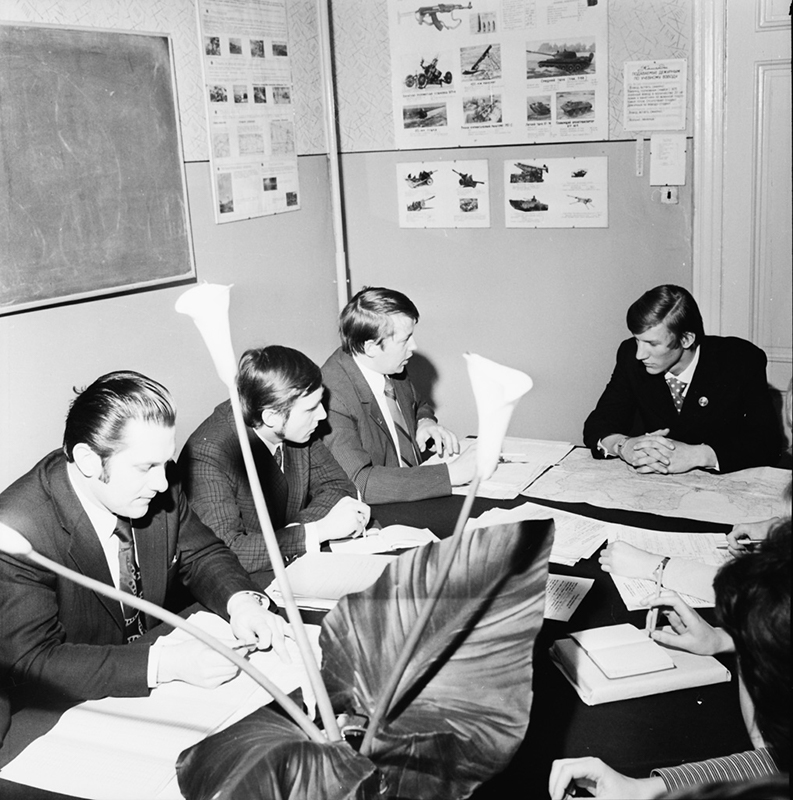 In 1975 during my last – the sixth, year of studies at the Rīga Medical Institute two commissions were organised: the public and national distribution. I think the photo shows the public distribution that was held at the premises of the Military Department at 12 Padomju bulvāris (now Zigfrīda Annas Meierovica bulvāris).
In 1975 during my last – the sixth, year of studies at the Rīga Medical Institute two commissions were organised: the public and national distribution. I think the photo shows the public distribution that was held at the premises of the Military Department at 12 Padomju bulvāris (now Zigfrīda Annas Meierovica bulvāris).The public distribution assessed study results, public activities, participation in amateur performance groups (choir, dance group), and participation in the Students’ Scientific Society (hobby groups by departments) of each student. There was a set order in the queue of the public distribution relating to these criteria. I am pretty sure that some of the commission members received additional information from the Vice-Rector of ideological education Jūlijs Kairovs about each student.
The national distribution at that time was within the competence of the Latvian SSR Ministry of Health Care with official assignment to a particular workplace.
From the left: Jānis Gulbis – Deputy Head of the Human Resources Department of the Ministry of Health Care of the LSSR; Aleksandrs Kačanovs – representative of the Course Party Committee (secretary), graduate of 1975, later he worked at the Physicians' Qualification Institute of Leningrad; Andris Timbers – head of our course, graduate of 1975, later he was lecturer at the P. Stradiņš Vascular and General Surgery Department; Egīls Cunskis – President of the Students’ Scientific Society, currently Head Physician of the Operating Block at the Riga East Clinical University Hospital.
- Story of the Head of the Council of Higher Education, RSU Professor Jānis Vētra
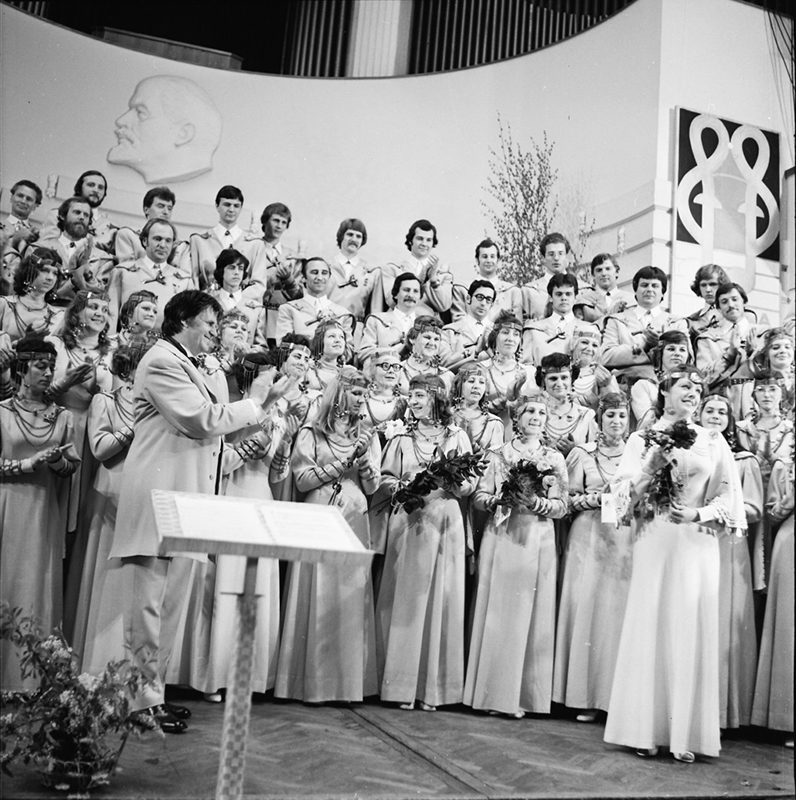 The photo has captured one of the many anniversaries of the choir Rīga around 1980. I say many, because the choir celebrated the anniversary of its date of foundation as well as the first day at the choir of maestro Jānis Dūmiņš, as well as other events that all chorus singers were not even aware of, but there still was a party. The celebration concert usually was held in the Great Hall of the State University of Latvia that was decorated with birch-boughs. Chorus singers have flowers in their hands, smiles on their faces and joyful looks. Chorus singers liked, sometimes even were thrilled about collaboration with the soloist Elga Brahmane. Most probably, they have just finished the Russian folk song Nad poljami (Over the fields), which Elga Brahmane and maestro Jānis Dūmiņš made especially enthralling and emotionally uplifting. Folk song arrangements were the choir's forte. At its anniversary concert the choir Rīga performed songs in 21 different languages – Latvian, Lithuanian, Estonian, Russian, Ukrainian, Georgian, German, Finnish, Swedish, etc. It was the special talent of maestro – to find the particular character of each nation that is expressed in the folk songs. Also the public enjoyed the folk music program the most – many songs had to be repeated. Chorus singers – to mention some of the people in the photograph: in the top row from the right, the current Associate Professor, Orthopaedist Mārcis Krūmiņš, Urologist Atis Karulis, Professor and Rehabilitator Aivars Vētra, Professor Jānis Vētra, Second Conductor Kārlis Beinerts, Surgeon Jānis Dūmiņš (fourth), Orthopaedist Normunds Pavlovs, Radiologist Daumants Dravnieks, in the first row from the right Cardiac Surgeon Miķelis Jagmanis, Surgeon Arnolds Ķirsis, Lecturer and Internist Jānis Skārds, – still remember the joyful sense of contentment they had after the concerts.
The photo has captured one of the many anniversaries of the choir Rīga around 1980. I say many, because the choir celebrated the anniversary of its date of foundation as well as the first day at the choir of maestro Jānis Dūmiņš, as well as other events that all chorus singers were not even aware of, but there still was a party. The celebration concert usually was held in the Great Hall of the State University of Latvia that was decorated with birch-boughs. Chorus singers have flowers in their hands, smiles on their faces and joyful looks. Chorus singers liked, sometimes even were thrilled about collaboration with the soloist Elga Brahmane. Most probably, they have just finished the Russian folk song Nad poljami (Over the fields), which Elga Brahmane and maestro Jānis Dūmiņš made especially enthralling and emotionally uplifting. Folk song arrangements were the choir's forte. At its anniversary concert the choir Rīga performed songs in 21 different languages – Latvian, Lithuanian, Estonian, Russian, Ukrainian, Georgian, German, Finnish, Swedish, etc. It was the special talent of maestro – to find the particular character of each nation that is expressed in the folk songs. Also the public enjoyed the folk music program the most – many songs had to be repeated. Chorus singers – to mention some of the people in the photograph: in the top row from the right, the current Associate Professor, Orthopaedist Mārcis Krūmiņš, Urologist Atis Karulis, Professor and Rehabilitator Aivars Vētra, Professor Jānis Vētra, Second Conductor Kārlis Beinerts, Surgeon Jānis Dūmiņš (fourth), Orthopaedist Normunds Pavlovs, Radiologist Daumants Dravnieks, in the first row from the right Cardiac Surgeon Miķelis Jagmanis, Surgeon Arnolds Ķirsis, Lecturer and Internist Jānis Skārds, – still remember the joyful sense of contentment they had after the concerts.- Story of Physician, RMI graduate and former RSU Lecturer Irīna Kalniņa
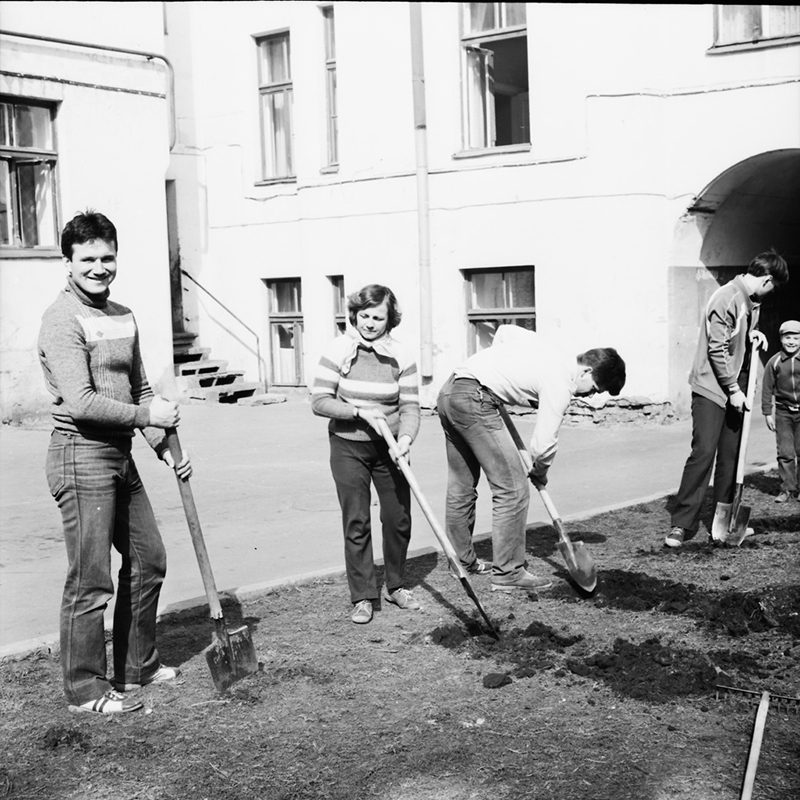 The communist subbotniks (volunteer unpaid work on Saturdays) were held each April – to celebrate Lenin’s birthday. It was mandatory for students and lecturers to participate in subbotniks. The money earned by this work was transferred, for example, to the Heroic Vietnam Foundation.
The communist subbotniks (volunteer unpaid work on Saturdays) were held each April – to celebrate Lenin’s birthday. It was mandatory for students and lecturers to participate in subbotniks. The money earned by this work was transferred, for example, to the Heroic Vietnam Foundation.I remember in the early 1980s during one of the subbotniks the RMI students had to clean an area in Pārdaugava, where construction of the Uzvara Monument was underway. Students had to not only clean the area, but also it was mandatory to voluntarily donate money towards the construction of the monument.
- Story of Physician Zane Gaile
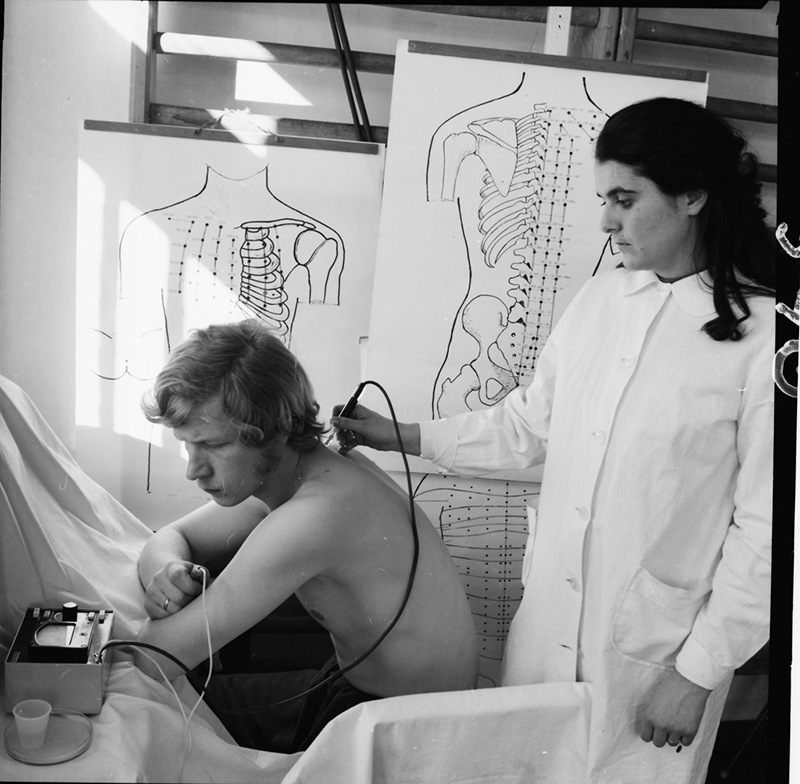 It seems the story of the photograph shows a Students’ Scientific Society, one of the hobby groups – electrical resistance of the body is being measured in various reflexogenous zones.
It seems the story of the photograph shows a Students’ Scientific Society, one of the hobby groups – electrical resistance of the body is being measured in various reflexogenous zones.During the 1970-1980s all students of the Rīga Medical Institute (RMI) had to participate in a Students’ Scientific Society hobby group. These groups held regular meetings on a particular topic, the latest studies were presented. The most hard-working and interested students carried out studies themselves, and presented the results in scientific conferences of the RMI and of the USSR.
My debut was outside Latvia, in Kaunas, and of course in Russian.
I still remember that there was a photo laboratory at the RMI, where good quality slides were made for these presentations.
- Story of Microsurgeon Haralds Adovičs
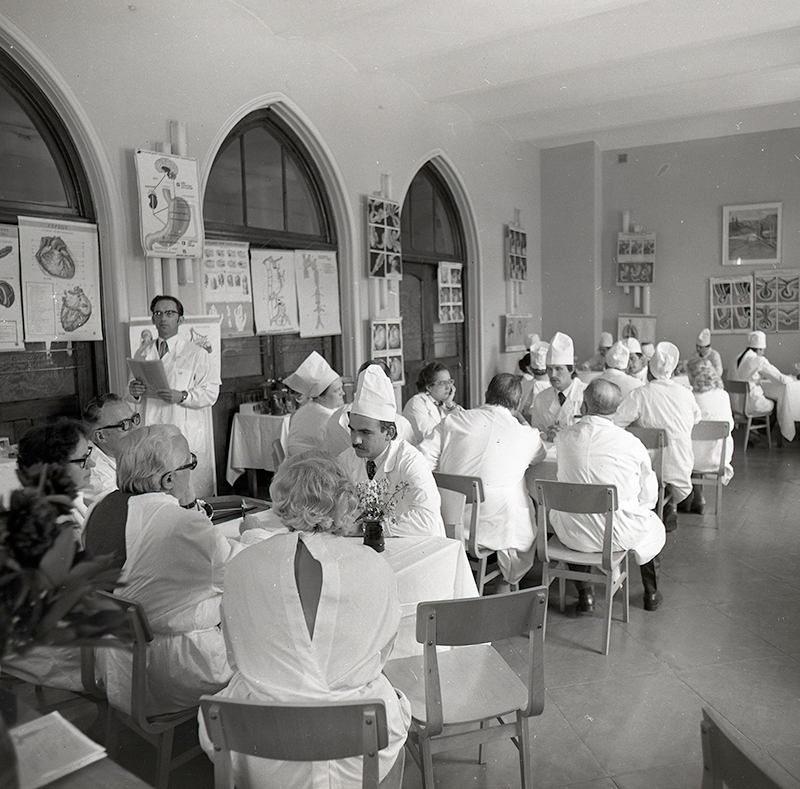 The 1982 state exam in surgery was held on the premises of the Riga 1st hospital (former Nikolai Burdenko Riga City 1st Clinical Emergency Hospital). The conference hall was adapted for the purposes of the exam. In order to speed up the examination process, students were simultaneously assessed by several groups of examiners. To emphasise the importance of anatomy knowledge for prospective surgeons, the walls of the hall were covered with various anatomy-related posters, which, or course, made us worry – will the knowledge of anatomy be tested in depth? As it was common back then, a substantial prerequisite of a surgeon was a well-starched hat. Potato starch was not spared! The examiners on the commission represented various fields.
The 1982 state exam in surgery was held on the premises of the Riga 1st hospital (former Nikolai Burdenko Riga City 1st Clinical Emergency Hospital). The conference hall was adapted for the purposes of the exam. In order to speed up the examination process, students were simultaneously assessed by several groups of examiners. To emphasise the importance of anatomy knowledge for prospective surgeons, the walls of the hall were covered with various anatomy-related posters, which, or course, made us worry – will the knowledge of anatomy be tested in depth? As it was common back then, a substantial prerequisite of a surgeon was a well-starched hat. Potato starch was not spared! The examiners on the commission represented various fields.My commission included (in the picture from the left) Radiology Lecturer Jevgenijs Nemiro, Anatomy Professor Genovefa Jēča, Traumatology and Orthopaedics Professor Eduards Žeidurs.
The commission at the other table (second from the left) consisted of Head Lecturer of Surgery, Physician Maija Pūce, Surgery Professor Jānis Volkolakovs, Surgery Lecturer Anatolijs Ņikitins. They were assessing Aivars Lācarus.
At the next table Imārs Indāns presented his knowledge to the commission.
In order to ensure an honest and smooth examination process, it was observed by the Vice-Dean of the Medicine Faculty of the Rīga Medical Institute, Assistant Professor Ivans Zagorskis.Of course the exam was just the beginning of our road. Imārs commenced his work at the Madona Hospital, but his life came to a sudden stop in 1986 in Chernobyl.
Aivars Lācarus, after his internship in 1983 moved to Talsi – initially he worked as a surgeon-physician and urologist, later he was Chief Physician of the Talsi Hospital and an active public and political servant.For me the exam was successful, my result was excellent. I am grateful that I had the opportunity to improve my knowledge at the clinical traineeship in surgery. It was led by the outstanding surgeon and scientist, Professor Vilis Purmalis. Under his supervision the new speciality – microsurgery was introduced in Latvia. And who would have thought – after completion of the clinical traineeship, the Centre of Microsurgery became my only place of work…




